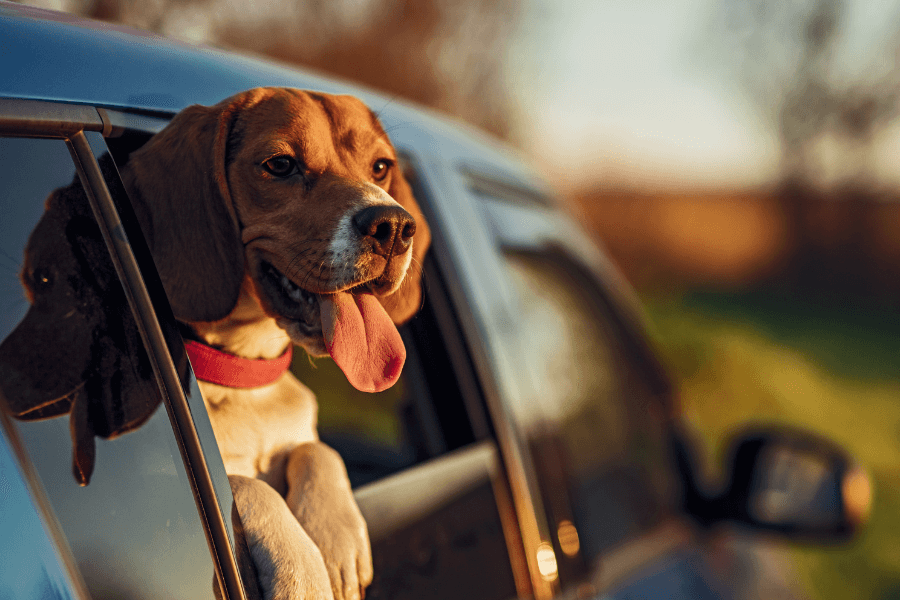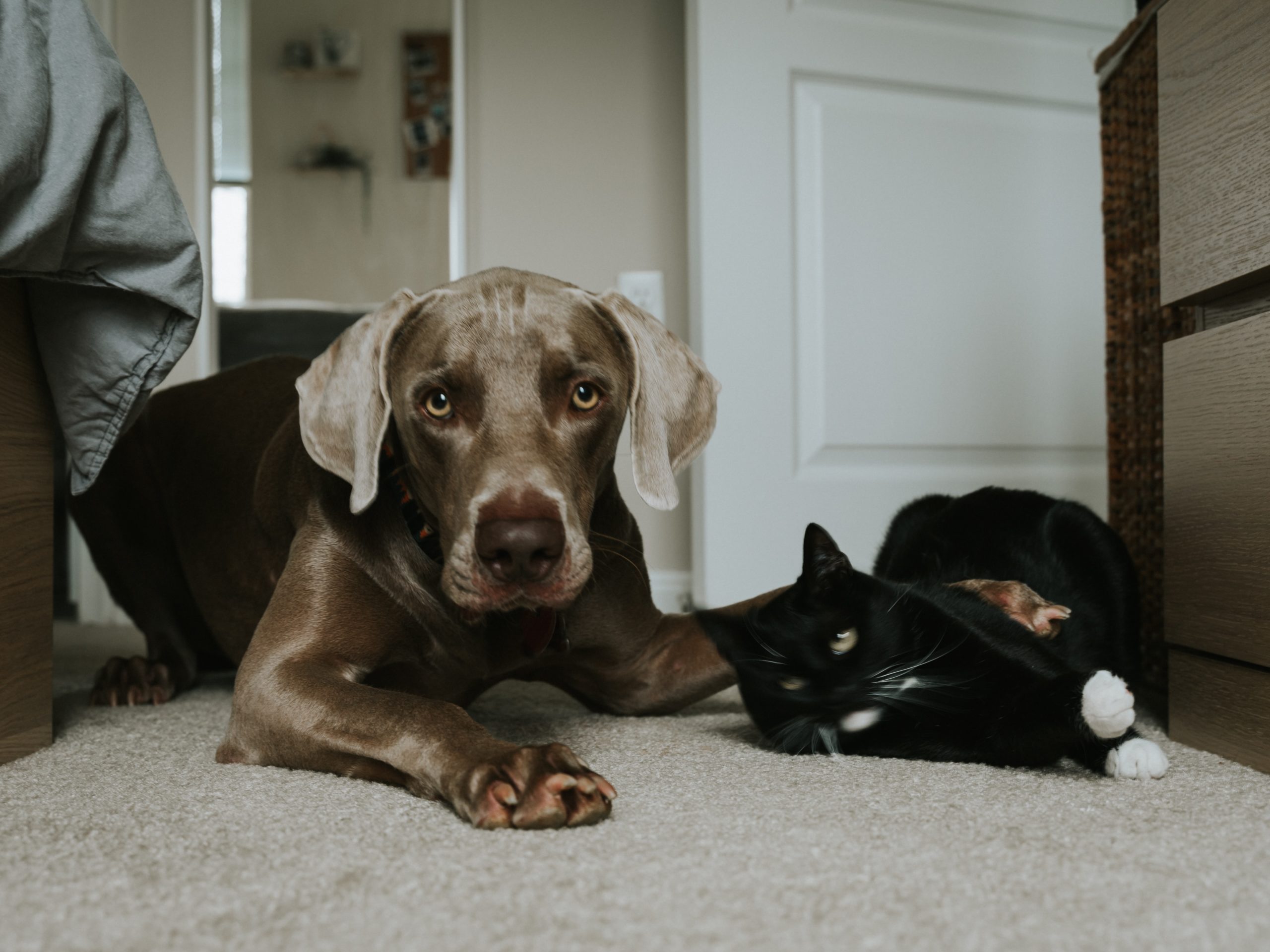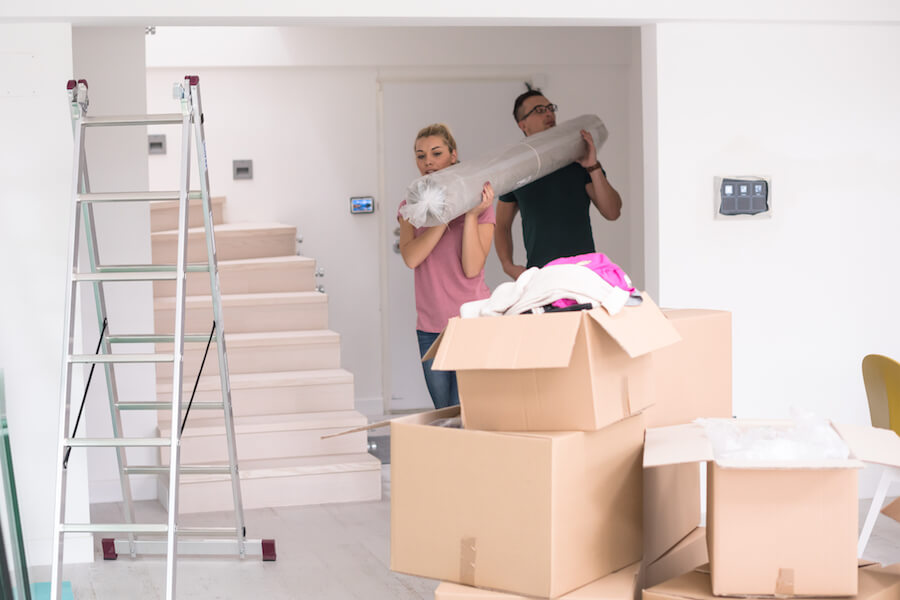Moving is a big upheaval for all involved, not least of all your doggie fur babies. Moving house with a dog (or dogs) could be a breeze or a battle depending on your pet’s temperament. In times of change and chaos it can be a little difficult to focus on understanding their individual needs. Making sure they don’t feel anxious, are removed from their routine too much, or even go missing, is a constant responsibility at the best of times, but it’s extra important when moving home with a dog. Regardless of it being a big move or a small one, there will be a new environment, new neighbours, new dog parks, and new smells!
Your dog will know that change is afoot, so keeping them contained, comfortable, and calm will take a lot of planning. So, when you are moving house with your dog, you need to be prepared!
Whether it is a pampered pooch or a tough working dog, we have some tips for a successful pet transfer. Our “moving home with dogs” guide will get you and your best mate/s settled in no time after you’ve found a removalist for the big move.
Is moving stressful for dogs?
You likely know that dogs are territorial creatures, they mark their smells around and about their regular spaces so other dogs will know their “calling card”. When they are removed from their regular space, they may become anxious or agitated until they have acquainted themselves with their new area. This means getting to know the new smells and dogs whose neighbourhood they have moved into. The biggest difference to them will be the absence of their own odours, but also your familiar smell is not yet embedded around the place yet, so during this transition it’s important to give them a lot of extra love and affection for reassurance.
Dogs are also very habitual so a change of environment could be a big shake up, particularly if the move is long distance, but even little moves can be jarring to sensitive pups. Also, as moving becomes stressful for their owners, they will know you are out of your usual routine. You should always plan to combat your dog’s stress, even if you don’t need to in the end.
Do dogs get sad when you move?
It’s widely accepted that dogs can suffer from depression, though not necessarily like humans do, but moving with your dog could trigger a sad or depressed response if they were particularly attached to their old stomping grounds or someone who lived there. The good news is that it is rare for it to last very long so when they get used to all the benefits of their new surrounds, and distribute their territorial odour, they should hopefully relax into a new life and routine. If it seems to be taking longer than you think it should, maybe take them for a vet checkup!
What are the signs of anxiety in dogs?
In the throes of a move, you may not necessarily be in tune with what your dog is trying to communicate, with everything going on before the move, it could be easy to miss the signs of dog anxiety when moving house. If you are aware of what to be on the lookout for though, and you keep their needs in mind, you will identify their stress signs sooner rather than later.
When preparing your dog for the move, be aware of some of these common stress signs in dogs:
- Shivering
- Barking and howling, particularly when no one is home
- Destroying objects and/or aggression
- Drooling, panting and/or pacing
- Digging for no reason
- Escaping their yard or running away
- Cowering in small spaces or corners
- Compulsive self-harm such as excessive chewing or licking.

What dog breeds are prone to anxiety?
Some dog breeds are more prone to stress and anxiety than others, and if you are in tune with your pooch, you will understand if they are a stressful pup. But if you own one of these breeds (among others) you may need extra precautions and be extra sensitive to their behaviour when preparing your dog for a move.
- Greyhound
- Sheltie
- Border Collie
- Bichon Frise
- Toy Poodle / Poodle
- Labrador Retriever
- Jack Russel Terrier
- Soft-Coated Wheaten Terrier
- English Cocker Spaniel
- Cavalier King Charles Spaniel
- Miniature Schnauzer
- German Shorthaired Pointer
- German Shepherd
- Australian Shepherd
- Vizsla
- Lagotto Romagnolo
- Spanish Water Dog
That’s not to say that other breeds won’t be fragile and suffer dog anxiety during a move or change in routine and environment as well though, so make sure you have all their creature comforts available. Be prepared to manage any of their negative stress behaviours with reassurance and positive reinforcement.
How to prepare dogs before a move
You can start preparing your dog for a move weeks ahead by getting your dog used to moving supplies and having boxes around, start moving furniture slowly, and don’t pack any of their things until the last minute. If you are preparing your dog for a move somewhere that is close by, take them to some of the new places they will be visiting before the move. You should also factor in as much extra time as possible for play and exercise, and use treats as much as you need to for reinforcing positive behaviours. Asking your vet for advice on how to reduce dog anxiety when moving house may also provide some extra support, and you can ask them about natural calming products for dogs that may help them stay happy on moving day.
Find for information about how to help your doggie with separation anxiety.
What to do with dogs when moving house
It is highly likely that moving day will be fraught with stress for yourself and having your dog losing their cool during the pandemonium is something you really don’t need. So, you will need to plan what to do with a dog when you move house.
You may consider finding a sitter during the move, someone you know is trusted and that your dog will trust. If you think your dog will be less stressed by being away from you altogether, you might consider booking them in for a short stay in a pet hotel for some pampering while you do all the moving. Or if they aren’t that privileged, they could stay at a kennel or cattery for the time you need to move.
Alternatively, if they must be around you, the best way to move with dogs is to consider popping them on their leash for a time or securing them in a room or garage so they don’t get excited by strangers (such as your removalists) or get tempted to run out an open door or gate. The last thing you need during the move is a missing dog hunt.
If your pup has medical needs at the time of your move, you may need to get specific veterinary advice. For instance, getting advice on how to move a dog with a broken leg, or how to move a dog with spinal injuries, could be especially important if the move will be long distance or you need to provide them with special care during the move.
Moving with a dog in the car
In Australian states and territories, you must adhere to traffic and animal welfare rules and regulations when transporting dogs in vehicles. This is also the case when moving home with dogs in your car. It is prohibited to have a dog in the driver’s area of any vehicle everywhere in Australia.
Depending on which state you are moving within or to with your dog in the car, you should read up on the rules for that jurisdiction before you travel to avoid any trouble.
You can find the rules for driving with animals in your car when moving interstate for each state and territory below:
- Queensland
- New South Wales
- Australian Capital Territory
- Victoria
- Tasmania
- South Australia
- Western Australia
- Northern Territory
Companies like Muval can also offer integrated interstate removalist services to help coordinate the timing for your goods to arrive at the same time with your drive to your new location
Moving with multiple dogs
If you own more than one dog (more than 15 and you are an official doggo hoarder), you will need to consider all the things above for each dog that you own, as they will need to feel your individual attention, particularly if one or more of them are anxious dogs.
As multi-dog owners know though, there are tricks and treats that you can use to have your little pack family feeling comfortable, and as for humans is for dogs, comfort and safety is often in numbers.
The real challenge is when you bring them to a new space, as they will all have their own feeling and finding to do in their new environment. Keeping an eye on each of them while you unload and unpack may be tricky, and you will need to make sure the new yard is pet proofed as a top priority.
You may face new toilet habit challenges, conflicts with other animals in the new territory, or roaming and escape attempts. For a while they may also bark a lot with the local dogs as they all get to know each other better.
How to do a long distance move with a dog
Moving has a whole extra dimension when moving long distance with dogs, and it can be a bit of a minefield to figure out how to move your dog to another state. You need to prepare them for the trip in a myriad of emotional and physical ways. Moving long distance within your current state is one thing, but there will be extra red tape involved moving between council areas, and likewise if you are moving across state borders.
Arranging for a dog to move a long distance can become a significant contributing expense on top of your other costs. You may need special vet care for the trip if you pup is anxious or has special needs (remember some breeds can’t travel well because of Brachycephalic Syndrome), or you may need to transport your dog separately if travelling by air, bus, or train. Even if you are driving the distance with your dog, you will need to have a lot of patience, treats, and time for toilet breaks.
You will need to register your dog with your new Local Government Area’s council and update their microchip details. You may be eligible for a discount on your registration if:
- Your dog is a working animal for a verified organisation or is a service dog
- Your dog is over 10 years old
- You have a desexing certificate for your dog
- You are a registered dog breeder
- You are a pensioner or hold a valid concession card for the Department of Health and Human Services or the Department of Veterans Affairs.
Read more great info about registering your pet in each Australian state.
Some states do not allow certain dogs (restricted breeds) across the border, so look up the regulations on which breeds your new state will let you keep as pets.
There are lots of companies around that will take care of moving your dog from base to base for you, so this may be a worthwhile option if you want to hand the entire process over to a third party. These pet transport specialists know all the ins and outs of long-distance dog journeys and offer a range of extra comforts such as insurance and air-conditioning. Regardless of being a road trip or a flight, these companies will coordinate with trusted animal transporters and have dedicated caring staff to treat your pup like a VIP.

Moving overseas with dogs
Moving long distance with a dog within Australia is one thing but moving countries with a dog is a whole new ballgame. Finding a trusted pet transport expert in this case is imperative and unavoidable, not least of all for your dog’s safety, but to help negotiate the huge amount of red tape that is inevitable when importing an animal into a foreign country.
Here are the basics of what you should be thinking about, but you should always research your own pathway for your dog’s journey according to their personal care needs, temperament, and the rules for importing animals into the country you are moving to.
- Your dog will need to travel in an approved animal transport crate. This is important because it’s how your best friend will be traveling on the plane and will need to be comfortable, but also satisfy all airline specifications. You should get your dog used to being inside a crate as soon as you know they will need to travel in one, you can get professional animal behaviourists to help with this.
- Microchip! Most countries require you to have your dog microchipped prior to entry. It will contain your dog’s vaccination details, health records, and your contact info. A vet or customs staff will then be able to access this information quickly if required.
- Find out the animal import requirements for the country you are moving to. You will need to follow them to the letter, and each country has their own rules based on where you are flying in from.
- When internationally importing animals, you need to be aware of the rabies status of the country you are leaving and the country you are entering. The country categories determine if a nation is rabies free, rabies controlled, or has a high rate of rabies in the animal community. Moving between similar country categories can be easier than moving from one category to another. It’s best to seek out advice on this before you book any transport. You can find more information at the Australian Government Department of Agriculture, Fisheries and Forestry. You will also need to declare your dog doesn’t have rabies after they have undergone the rabies titre test by an official government veterinarian within Australia as the country of export.
- Make sure your dog is up to date with their internal and external parasite treatments as many countries will check that treatments for external pests like ticks and fleas, and internal parasites such as heart worm and tapeworm have been done.
- Some countries require your dog to have an accredited vet provide them with a current health care certificate (particularly in the EU) which will outline all your pet’s health treatments provided in a prescribed format, or even a pet passport!
- You will need to apply for an import certificate for your pet to be allowed to enter another country, almost like a doggie visa.
- Different countries have different quarantine rules for dogs which directly relate to the category of the country you are importing from. Find out what the regulations are for the country you are going to prior to moving abroad with a dog.
Pets are generally not fed during their flight and not attended to with water. You will need to make sure they are fed well no later than six hours prior to flying. Their water dish will need to be securely attached to the inside of their crate and filled up as much as possible, so they stay hydrated.
How to help your dog settle into a new home
While some dogs will adjust quickly and smoothly to their new place, you can still expect this process to take weeks, and sometimes months, depending on your dog’s temperament. Be patient and diligent and they will get used to being around new smells and sounds.
When you first get into your new home, make a place that is special and comfortable for your dog and show them you have made them a safe place to return to.
Try to replicate all the routines from your previous home as best you can. Take walks at the same time of day and for a while in the same neighbourhood around home, slowly introduce them to more and more fun dog spaces. The dog park is probably not the best place to start.
Keep as many of the same things in your new home as in your last one if possible so they can know that there is continuity from one place to the other (even arrange them in a similar way if you can). Also, your smells and their smells will still be in them, helping them feel safe and giving them a sense of familiarity.
Try to hold off on the housewarming party, and visitors in general, until your pooch is settled, showing signs of happiness, and not exhibiting symptoms of anxiety.
Read more about the top 5 dog breed suited to apartment living.
Do dogs get homesick after moving?
Signs of being “homesick” in a dog are often them exhibiting stress and depression because of a change or loss. Dogs can be very expressive and communicate strongly with their bodies, eyes, bark, and whine – so it is important to be in tune with them throughout the process of moving, but also to especially monitor them after the move. Immediately following the move is a critical time for them so when you have already done all the comforting and routine building you can, you should watch for signs of them being off their food, persistent whining, not interested in play. They may also be reluctant to toilet themselves as this fundamental routine is the most disturbed when they are removed from their usual poop and pee place, so you will need to re-train them to toilet in a new part of the yard, using treats can help with positive reinforcement.
How do you acclimate a dog to a new home?
Don’t underestimate the impact that moving can have on your dog. Leaving their safe space can activate some deep fear behaviours and sometimes they will act out in negative ways. Be aware too, that if you are showing signs of stress, they will notice and take it on themselves. Essentially, your doggie is experiencing a form of separation anxiety from their old life and the best remedy is for them to find all the same routines and some awesome new parks and places for them to find the fun in their new life. It may be rough for the first few days or weeks, but your dog will eventually find their full potential in their new future.
How do dogs adjust to a new home?
Just like people, change takes a little getting used to for dogs, but if you are keeping calm and exhibiting constant reassurance to them, they will follow your lead. Adjusting to a new home means new boundaries, rules, and routines. New people and new pets in the neighbourhood could be triggering but if you are finding that you have less control over your pup than you used to, a puppy training school could be a good place to turn to for advice.
Find them a good vet too, so that if the stress gets overwhelming you know where to go straight away. Make sure you keep up their walking routine, so they can feel themselves getting to know the neighbourhood on their own terms, start with small walks around the block or up the street and gradually expand the perimeter so they can get to know the smells. Find them a good dog park or of leash beach where they can have some free-spirited roaming and exploring too.

How do you make a sad dog happy?
Sometimes doggies just have a change of mood, just like we do, they can start to exhibit signs of sadness and depression that we instantly recognise as not their normal jumpy selves. This is a common problem when a routine change, such as moving, can alter their day to day ability to exhibit their normal everyday healthy behaviours.
But how can you cheer them up? Here are 5 ideas to try, but if you find they are persistently resistant to happiness, find a vet or animal behaviouralist to help get to the bottom of it.
- Ramp up the positive reinforcement for the smallest instances of good behaviour, both verbally and physically so they feel that they are doing the right things and encouraging more of those positive behaviours to come out more readily, if only for your attention and a treat to begin with. It will begin to form happy habits.
- Play games with them, unless they are really not feeling it, grab their favourite toy or ball and get them running and panting … just like in humans exercise is great for positive brain patterns and playing games adds an extra level of fun. It will begin to form happy habits.
- Avoid leaving them home alone if possible as loneliness can lead to boredom and further depressive behaviour. If you do need to leave them alone for a time, put a lot of effort into creating a safe dog space with all their creature comforts, but also add something in to bring them solitary excitement. You can buy slow feed treat dispensers or find ways to hide treats objects for them to find. Even having a friend or neighbour pop in for a quick pat can help them stay happier and calm, a dog walker could be the ultimate solution if you can afford one.
- Find some new treats to treat them with, is there something yummier out there for them. A new taste sensation may just be enough to motivate a tastebud driven dog to pull themselves out of that rut!
- Canine mindfulness may sound ridiculous but consider how you feel when you get a head massage. Now think of the look on your dog’s face when you give them a good pat. Having extra snuggle time with your dog and extending it to include more “massage” pats than usual could help bring their anxiety down naturally by encouraging a healthy heart rate and breathing pattern.
What can you do for dog anxiety?
Anxiety in dogs is treated nearly the same as it is for people. Regular exercise for good mental health and a healthy heart and lungs not only creates an inner peace but it’s great “in the moment mindfulness” for them to distract them from what is making them sad. Being in good company with a caring and trusted human will be the biggest comfort so encourage them to know you will always come home to them and that home is where you both are, no matter the décor! If nothing organic seems to be working, try asking your vet about calming treats, or consult with them further if this is an ongoing problem after the move.
How long does it take for a dog to adjust to a move?
Settling a dog into a new house has its challenges, but all in all, dogs are more like small children than we like to admit and time will prove that they will survive after the move and find their regular cadence. If you have found that you really can’t find how to make your dog comfortable after the move, and they are still not their usual self after a few weeks, you may choose to consult with a professional such as a veterinarian, dog trainer, or animal behavioural specialist to get to the heart of the problem.






